By Catherine Newell
In summer 2021, Amsterdam’s famous Rijksmuseum held its first exhibition on Slavery. The AfricaMuseum, in Belgium, reopened in 2018 after a renovation which aimed to confront its pro-colonial past. In the UK, the International Slavery Museum (ISM) opened in 2007 and is now looking to expand. Now that more people are paying attention to movements such as Black Lives Matter, and debates about representing the past are ever-present in our media, what role are these museums playing?
This summer, I had the opportunity to research these three museums, as part of a SURE research project. The project led to my podcast. It looks at how these museums have changed from when they were first created, and how they continue to change. It compares whose stories they tell: is the focus on individuals who were enslaved, or on wider systems of slavery? And how do these museums deal with the ongoing legacies of slavery, and racism in our society today?
The origins of the AfricaMuseum lie in the Brussels International Exhibition of 1897, when it hosted the exhibition’s Colonial Section. This included a human zoo, where 267 Congolese people were put on display, seven of whom died there. As late as 1958, the AfricaMuseum site housed African people brought over to work at the Brussels World’s Fair, which also included a human zoo. After over a century of pro-colonial exhibitions, in 2013 the museum closed for a renovation. It reopened in 2018, with new displays designed to showcase contemporary Africa and provide ‘critical reflections on our colonial past.’
The Rijksmuseum’s own thinktank has described it as a ‘temple of colonial self-overestimation.’ The museum needed to reinvent itself for its high-profile 2021 Slavery exhibition. This reinvention included reframing objects. A metal collar had been categorised as a dog collar since it entered the museum’s collection in 1881. While researching this exhibition, however, curators realised that it had probably been worn by an African man, and not a dog. The collar is now on display in the Slavery exhibition, alongside a painting of Paulus, a Black boy wearing a metal collar, and his ‘owner’. Sharing the telling miscategorisation of this collar shows a willingness to change how the museum researches and portrays Dutch history.
Paulus’ story is one of ten that the Rijksmuseum decided to focus on for the Slavery exhibition. There are many arguments in favour of focusing on individual people’s stories. One of the most compelling reasons is that few details remain about most enslaved people. Once enslaved, they were treated as less than human. When new details are uncovered, we have an obligation to share them, and thus to restore the dignity and humanity of the enslaved people.
On the other hand, it’s important to remember that colonial slavery was a worldwide system of exploitation that lasted for centuries. The ISM focuses on this wider picture. In the centre of the museum, there’s a recreation of a slave ship. Visitors are surrounded by screens, which show clips of people in pain, sometimes vomiting, often naked. These people are anonymous. Millions of people were forced onto slave ships, not just the few whose names we still know. Even without their names or individual stories, visitors can see their suffering.
All three museums discuss the continuing effects of slavery. The Rijksmuseum’s audiotour is voiced by the descendants of enslaved people, showing a direct link between past and present. The AfricaMuseum and the ISM also address modern-day racism. The ISM explores the legacies of slavery in the UK and around the world. This again highlights the massive scale of slavery, but could focussing more on British racism have a bigger impact on visitors?
Museums don’t just show us the past. They reflect our current society and our present-day attitudes towards the past. Every time a museum is renovated or has a new exhibition, curators have to make decisions about which stories they tell, and how they tell them. As public attitudes continue to change, how will our museums keep changing?
Catherine Newell is a BAMLC student at the University of Sheffield. She studies Dutch, French and German. Her SURE project was supervised by Henriette Louwerse.


